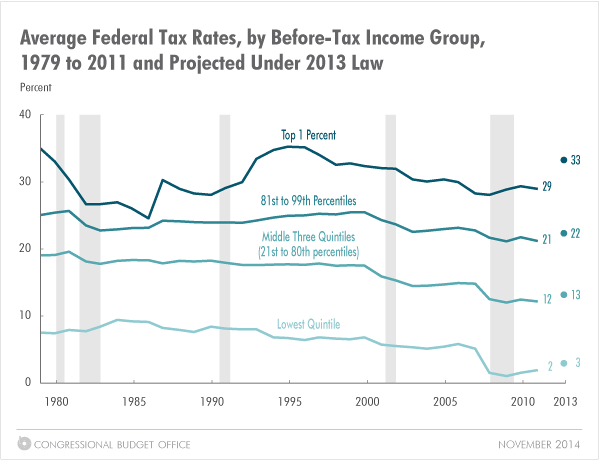November 12, 2014 - In 2011, according to CBO's estimates, average household market income—a comprehensive income measure that consists of labor income, business income, capital income (including capital gains), and retirement income—was approximately $81,000. Government transfers, which include benefits from programs such as Social Security, Medicare, and unemployment insurance, averaged approximately $13,000 per household. The sum of those two amounts, which equals before-tax income, was about $94,000, on average. Federal taxes as examined in this report comprise four separate sources: individual income taxes, payroll (or social insurance) taxes, corporate income taxes, and excise taxes. Taken together, those taxes were about $17,000 per household, on average, in 2011. Thus, average household income after taxes was about $77,000, and the average federal tax rate (federal taxes divided by before-tax income) was 17.6 percent.
How Were Income and Federal Taxes Distributed in 2011?
Before-tax income was unevenly distributed across households in 2011. Average before-tax income among households in the lowest one-fifth (or quintile) of the distribution of before-tax income was approximately $25,000 in 2011, CBO estimates (see table below). Among households in the middle income quintile, average before-tax income was about $66,000. Relative to those two income groups, households in the highest income quintile had average before-tax income that was much higher—approximately $246,000.
Overall, federal taxes are progressive, meaning that average tax rates generally rise as income increases. Households in the lowest income quintile paid about $500 in federal taxes in 2011, on average, which amounted to an average federal tax rate of about 2 percent, CBO estimates. Households in the middle quintile paid about $7,000 in federal taxes, and households in the highest quintile paid about $58,000 in federal taxes, which results in average federal tax rates of approximately 11 percent and 23 percent, respectively.
As a result of the progressive federal tax structure, households in the highest quintile of before-tax income paid a greater share of federal taxes in 2011 than they received in before-tax income, while households in each of the other quintiles paid a smaller share of federal taxes than they received in before-tax income (see figure below). Households in the highest income quintile received a little more than half of total before-tax income and paid more than two-thirds of all federal taxes in 2011. In contrast, households in the lowest income quintile received approximately 5 percent of total before-tax income in 2011 and paid less than 1 percent of all federal taxes, CBO estimates.

The progressive federal tax structure also results in a distribution of after-tax income that is slightly more even than that of before-tax income. Households in the lowest income quintile received approximately 6 percent of after-tax income in 2011, compared with 5 percent of before-tax income, and households in the highest income quintile received about 48 percent of after-tax income, compared with 52 percent of before-tax income, CBO estimates.
How Did Changes in Tax Rules Between 2011 and 2013 Affect Average Federal Tax Rates?
Tax rules have changed since 2011 in several important ways. Most notably, by 2013, several provisions affecting high-income taxpayers—originally enacted in 2001 (in the Economic Growth and Tax Relief Reconciliation Act, or EGTRRA) and 2003 (in the Jobs and Growth Tax Relief Reconciliation Act, or JGTRRA)—were allowed to expire. In addition, payroll tax rates that had been reduced in 2011 and 2012 were reset to their previous, higher levels in 2013, and new taxes for high-income taxpayers enacted in the Affordable Care Act took effect in 2013. As part of this analysis, CBO estimated the effects of those changes on the distribution of federal taxes.If the income distribution was unchanged between 2011 and 2013, the average federal tax rate for all households would have been 1.7 percentage points higher under 2013 tax rules than it was in 2011, CBO estimates. Although average federal tax rates would have increased by about 1 percentage point across much of the income distribution, the average tax rate for households in the top 1 percent of the income distribution would have increased by an estimated 4.3 percentage points.
What Are the Trends in the Distribution of Household Income and Federal Taxes?
Over the 33-year period from 1979 to 2011, average after-tax income—which equals market income plus government transfers minus federal taxes—grew at significantly different rates at different points in the income scale. For households in the top 1 percent of the income distribution, inflation-adjusted after-tax income grew at an estimated average rate of 3.5 percent per year. As a result, inflation-adjusted after-tax income was 200 percent higher in 2011 than it was in 1979 for households in that group. In contrast, households in the bottom quintile experienced inflation-adjusted after-tax income growth of 1.2 percent per year, on average. Consequently, inflation-adjusted after-tax income was 48 percent higher in 2011 than it was in 1979 for that income group. Those differences in growth rates for after-tax income are largely attributable to differences in growth rates for market income, although changes in taxes and transfers played a role as well.Average federal tax rates fluctuate over time because of changes in tax law and changes in the composition and distribution of income. In 2011, average federal tax rates were near their lowest levels since 1979 for households in most of the income groups examined in this report. The only exception was for households in the top 1 percent of the income distribution. For that group, the average federal tax rate in 2011 was near its lowest level since the early 1990s (see figure below).
CBO estimates that average federal tax rates under 2013 law would be higher—relative to tax rates in 2011—across the income spectrum. The estimated rates under 2013 law would still be well below the average rates from 1979 through 2011 for the bottom four income quintiles, slightly below the average rate over that period for households in the 81st through 99th percentiles, and well above the average rate over that period for households in the top 1 percent of the income distribution.

Government transfers and federal taxes lessen income inequality because federal taxes are progressive and payments from government transfer programs generally decline as a share of income as income rises. Between 1979 and 2011, government transfers reduced income inequality to a greater extent than federal taxes, based on a standard measure of inequality known as the Gini index. In 2011, government transfers accounted for approximately two-thirds of the reduction in income inequality observed between market income and after-tax income.








